Original rulebook / links:
Developer’s notes:
-
Please make sure that you have read the section about the online game before playing your first game.
- I recommend to read the original rulebook (English, PDF) which includes additional information about the delegates and the historical background of the Philadelphia Convention. You can find a download link above.
- This board game is available in English only. We are currently working on an (unofficial) German translation.
- For bug reports, suggestions for improvement or general questions regarding the rules please post to the respective subforums of the discussion board.
/Brer Bear
Overview
Your goal in Founding Fathers is to emerge from the Philadelphia Convention acknowledged by all as the true Father of the
Constitution due to your outstanding contributions to the final document. These contributions are measured by points on the
scoring track, so you will want to ensure that you have more of these than anyone else by game’s end. You can earn points in a
variety of ways, such as by casting state delegations’ votes according to your plans in the Assembly Room, or by filling the
Committee Room with your own loyal supporters. Points can also be earned by establishing yourself as the most vocal proponent
of one of the Convention’s powerful political factions, or simply by being the beneficiary of a favorable historical event.
Each turn, you will play one or more cards from your hand. Sometimes, you will play a group of delegates from a particular
state in order to persuade their delegation to vote the way you want them to in the Assembly Room. If you can muster enough
support for or against a proposal, you can earn significant points in recognition of this influence. Even if the voting goes
against you, however, there’s no cause for despair - your embittered supporters might still be able to work out a back room
deal in the Committee Room, earning you recognition in a more roundabout manner!
Other times, you might instead play a collection of delegates who share the same political viewpoint and take to the debate
floor in support of their cause. The more that the final Constitution ends up favoring that faction, the more points you stand
to earn by being that faction’s most eloquent spokesman.
On other occasions, you might choose to play a single card featuring an auspicious event. These events can have wide-ranging
effects, earning you points immediately or improving your situation in a way which you hope will earn you points later.
As you can see, there are many avenues available for gaining recognition at the Convention and earning the points you need
to win the game. The trick is to exploit these more effectively than your rivals, and to frustrate their efforts to do the same!
Components
- 1 game board
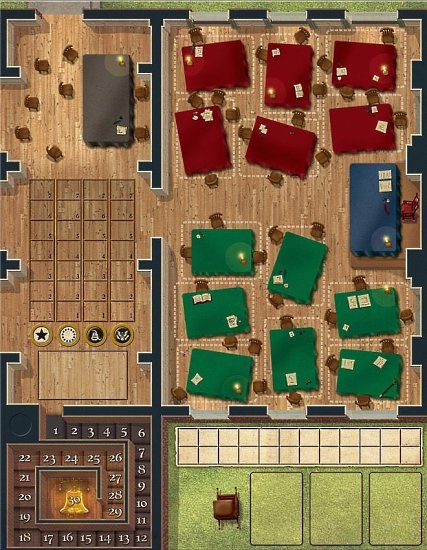
- 5 player reference boards


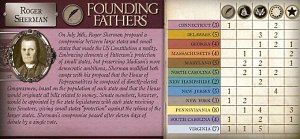


- 12 articles












- 55 delegate cards
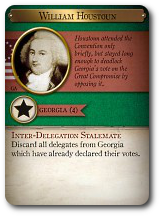
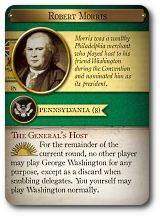
- 16 debate tokens




- 40 influence markers





- 12 voting chits


- 5 scoring markers
Setup
A)
Shuffle the appropriate set of player reference boards based on the number of players and
deal one at random to each player to determine which of the Planners they will be playing:
with
3 players use
Madison,
Paterson and
Sherman
with
4 players add
Pinckney
with
5 players add
Hamilton
B)
Give each player the delegate card and 3 influence markers for their Planner. Place the remaining influence markers in a
stockpile near the board. Put each player’s scoring marker near the score track.
The influence markers, scoring markers,
and reference boards for Planners not being represented by any player are returned to the box, as they will not be needed.
C)
Shuffle the remaining delegate cards, including those for any Planners which are not being represented by a
player in the current game. The player to the dealer’s right should then cut the deck by picking up approximately
half the deck from the top, placing it to one side, and then placing the remaining half of the deck on top of that. The
deck is then placed near the draw pool.
Shuffling the deck
Whenever the delegate deck is depleted, the discard pile should be reshuffled to form a new deck.
Any time the deck is shuffled, the player to the dealer’s right should cut the deck.
D)
Deal 4 delegate cards face-down to each player, starting to the dealer’s left and proceeding clockwise.
Of these, each player should keep 2 cards, discarding the others into a shared face-up discard pile
near the draw pool. The 2 cards each player keeps, plus their Planner card, make up that player’s 3-card
starting hand. Throughout the game, each player’s hand is called their caucus.
Caucus semi-secrecy
Players may keep the front sides of the delegate cards in their caucus hidden from other players, but the back of each card
displays the state and faction icons of that delegate; this information should remain visible to the other players.
E)
Draw 3 cards from the deck and place them face-down in the draw pool where they will be available for selection
when players need to refill their hands.

F)
Place the vote chits on the board near the voting tracker.



G)
Shuffle the articles, again allowing the player to the dealer’s right to cut. Stack the articles in their reserved spot on
the board. Draw 4 articles and place them to one side with their historical side up. (The historical side
is the side that does NOT have a red ring around the faction icon.)
These articles are considered resolved. Resolved articles should be spread such that the faction icon on each is visible to all players.
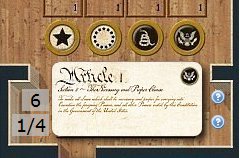




H)
Draw 2 articles, placing the first in the Assembly Room and the second in the Committee Room. Place these
articles with their historical side up.

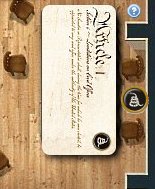
I)
Separate the debate tokens by faction icon and stack them on their matching spots near the Debate Floor.




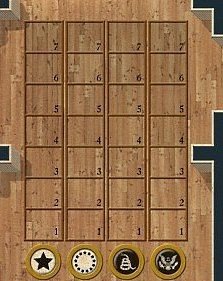
Sequence of play
In the first round of the game, the Madison player begins play by taking the first turn. Play proceeds clockwise in turn until
voting causes the Assembly Room to score, ending the round. Subsequent rounds begin with the next player in turn after the
one who caused the previous round to end. On their turn, a player performs one of the following actions:
- Declare a vote
- Speak in debate
- Enact an event
- Snub delegates
After taking an action, the player replenishes their caucus to 3 cards by choosing cards from the draw pool. Once they
have done so, new cards are drawn from the deck and placed face-down to bring the draw pool back up to 3 cards.
Using influence markers
Each player begins the game with 3 influence markers available;
additional influence markers may be gained during the game by enacting the
event featured on any Planner card. These markers are used in several ways:
- When declaring a vote, to identify a delegation’s controlling player.
- When speaking in debate, to advance a player along a faction’s debate track.
- At the end of each round, when influence markers are sent to the Committee Room.
If a player wishes to perform an action which requires placing an influence marker, but has no markers available, they may
freely remove one which is currently in use, reclaiming it and using it for the new action. If a player removes the influence
marker from a state delegation they control, that delegation’s cards remain in place and its vote will count normally at the
end of the round; it no longer has a controlling player, however, and no one will score points for it.
Whenever a player’s influence markers are removed from play for any reason, they are reclaimed immediately by their owner.
Declare a vote
A player may declare a vote by selecting one or more delegates of the same
state delegation from their caucus and voting them collectively either for or
against the article currently under consideration in the Assembly Room,
placing these cards on the appropriate side of the Assembly Room to indicate the
way they have voted (votes for the article going on the Yea side and votes
against on the Nay side) and marking them with one of their influence markers
to identify themselves as that delegation’s controlling player. If multiple cards are
played together, they should be spread such that the number of cards played and
the faction icon of each is visible, but only one influence marker is placed on
them regardless of the number of cards played.
To aid all players in quick assessment of the overall voting, place a vote chit from
the supply on the corresponding box of the voting tracker, marking that state’s
vote with a checkmark if the delegation voted for, or an x if the delegation voted
against. Remember to update the voting tracker if any course of events causes a
delegation’s vote to switch sides or be canceled.
All delegates played when declaring a vote must be eligible to declare their vote on the intended side of the article. There
are two restrictions on how delegates may declare their vote; Faction Bias and Overriding:
1.) Faction bias restrictions
Every article features a faction icon reflecting that article’s bias—the faction which will benefit most should that article
be adopted in its current form. Delegates are bound by their own faction loyalties (as indicated by the faction icons
featured on their cards) and may not vote against an article of their own faction or for one of the opposing faction.
2.) Overriding restrictions
Once a particular state delegation has declared its vote on an article,
that delegation may not have additional delegate cards added to it by
any player. The only way that state’s position can change is if it is overridden
by a different player (i.e., not the delegation’s controlling player).
To override a delegation which has already declared its vote, a player
must declare the votes of a larger number of delegate cards from the
same state onto the opposite side of the article. In this case, the
delegates which had previously declared their votes on the original side
of the article are discarded (with their controlling player reclaiming their
influence marker), and the new cards are placed on the other side of the
article and marked with an influence marker from the overriding player.
One state, one vote
Each state may only have one voting delegation at a time (composed of one or more delegates) in the Assembly Room for each
article, either for or against it. While this position may be overridden if enough delegates from the same state can be mustered on
the opposing side, it may not be "reinforced" by adding additional delegates after it has already declared its vote.
Speak in debate
A player may speak in debate by discarding one or more delegates of the same faction
from their caucus and either placing an influence marker on the appropriate space
on that faction’s debate track to reflect the number of delegates discarded (if this is the
first time that player has spoken for that faction in the current round) or advancing their
existing influence marker farther along that faction’s debate track the corresponding
number of spaces (if their marker is already on the track).
Enact an event
A player may enact an event by discarding one card from their caucus to resolve that card’s event text. A few conditions apply:
If the event features the rising sun icon, it is a persistent event which remains in
effect until the end of the round. The card should be placed face-up in front of
the person who played it so that it is visible to all players.
Some events allow a player to declare a delegate’s vote as part of the event. It is
handled in exactly the same way as the standard "declare a vote" action, meaning
additional delegates of the same state delegation may be voted along with it,
and the normal rules regarding Faction Bias and Overriding are in effect.
Some events allow a player to discard one or more delegates which have already
declared their vote as part of the event. If this results in the last delegate card of a
particular delegation being removed from the Assembly Room, the controlling
player’s influence marker is returned and that state becomes eligible to be
voted again; remember to clear that state’s vote chit off the voting track in that case.


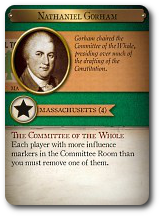
Events often break the game’s rules in a variety of ways. In all cases, the text of an event supersedes the normal rules of play.
Snub delegates
A player may snub delegates by discarding any number of cards from thei caucus. These cards are discarded without effect and
simply allow the player to replace them with new cards from the draw pool when replenishing at the end of their turn.
Replenishing the caucus
After performing one of the above actions (but before moving on to Ending the
Round, in the case that the action triggered it), a player replenishes their caucus to 3
cards by taking delegate cards from the draw pool. Once they has done so, new cards
are drawn from the delegate deck and placed face-down to fill the draw pool back up
to 3 cards. Note that after playing certain events, a player may be left with 3 or more
cards remaining in their caucus, and would therefore not draw any new cards that turn.
Reclaiming a planner
Whenever a player’s Planner card is revealed at the top of
the delegate deck after the deck is cut or a card is drawn,
that player may immediately reclaim it and add it back
into their caucus, even if it is not currently their turn.
Ending the round
A round ends when the article in the Assembly Room passes or fails as a result of the various state delegations declaring their
votes. Passing an article requires that a majority of the states (at least 7 out of the 12 present at the Convention) vote in its favor. If
at any time 7 different state delegations (not delegates) have declared their votes on the Yea side of the article in the Assembly
Room, a majority has been achieved and the article passes. Conversely, if at any time 6 different state delegations have declared
their votes on the Nay side, a majority has been blocked and the article has failed. Either outcome ends the round.
When a round ends, the following steps are taken, in order:
- Resolving the Assembly Room
- Resolving the Committee Room
- Resolving the Debates
- Resuming play
Resolving the Assembly Room
If the article in the Assembly Room passed, the delegates who voted for it are on the winning side, while those who voted
against it are on the losing side; if it failed, the opposite is true.
Any player who controls (has an influence marker on) one or more state delegations on the winning side gains points for each
delegate card in those delegations: 2 points for each delegate whose faction icon matches the currently-showing faction
bias of the article, and 1 point for each delegate featuring any other icon. All delegate cards on the winning side may then be
discarded, with all influence markers being returned to their players.
Any player who controls one or more state delegations on the losing side removes the influence markers from those delegations
and places them in the Committee Room. All delegate cards on the losing side may then be discarded.
If the article in the Assembly Room failed, it should now be flipped over to its reverse side (reversing its faction bias); if it
passed, it is left as it is. It is then placed with the other articles which have already been resolved.
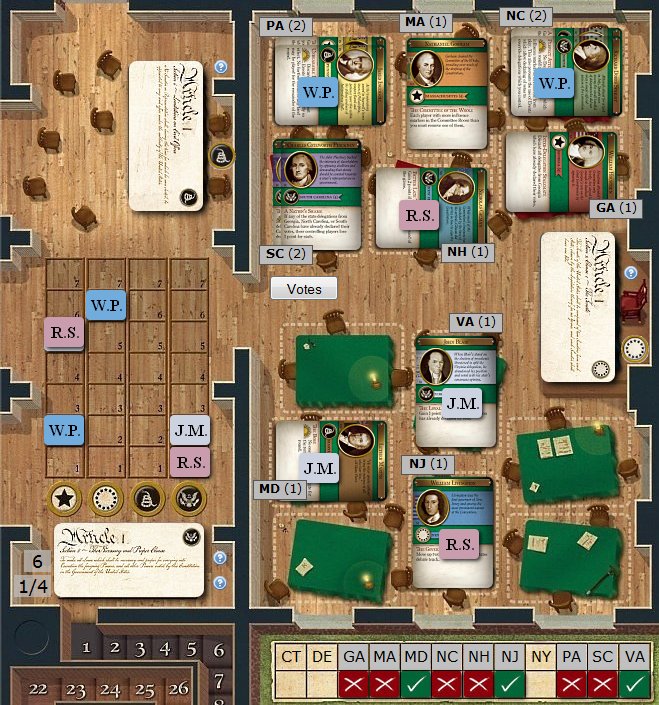
Example: A player has just cast the sixth delegation’s vote on
the Nay side, which blocks the majority and triggers the end of
the round by causing the article to fail. Therefore the Nay side
is the winning side, and the Yea side is the losing side.
First we look at the winning side. Any delegate whose faction
icon matches the article’s currently-showing faction bias will
score 2 points for its controller. Of course, since this is the Nay
side of the room, no delegates can possibly feature that icon.
(The 2-point bonus can thus only normally be earned by
delegates that voted Yea when the article has passed.)
Delegates featuring other icons will each earn 1 point for their
controllers. In this case, Sherman earns 1 point for his
delegate from New Hampshire, and Paterson earns a total of
4 points for his two from Pennsylvania and his two from
North Carolina. (Notice that there are other delegations on
the winning side as well, but since they don’t have influence
markers on them, nobody scores points from them.) Sherman
and Paterson both adjust their scores accordingly by moving
their scoring tokens on the score track, then reclaim their
influence markers from that side of the room. All delegate
cards on the Nay side are discarded.
Next we look at the losing side. All of the influence markers
there (two from Madison, one from Sherman) are moved to the
Committee Room, and all of the delegates there are discarded.
Finally, we look at the article. Since it failed, we flip it over to
reveal the other side (so that it now shows the Large States icon),
and place it with the other resolved articles near the board.
Resolving the Committee Room
Whichever player has the highest number of influence
markers in the Committee Room scores points equal to
that number and then reclaims all of their markers. No one
else scores points for their influence markers in the Committee
Room, and these markers remain in place. If multiple
players are tied for having the most influence markers in the
Committee Room, no one scores points for them and all
these markers remain in place.
If anyone scored points for the Committee Room, that
player has the option of flipping the article in the
Committee Room over to its reverse side (reversing its
faction bias) or leaving it as it is; if no one scored points,
it is left as it is. It is then placed with the other articles
which have already been resolved.
Resolving the Debates
Whichever player has advanced their influence marker the farthest
along each faction’s debate track receives a debate token for that
faction from the stacks near the Debate Floor. If multiple players are
tied for having advanced the farthest along a particular debate track
(or if no one spoke for that faction), no one receives a debate token
for that faction this round. After resolving the debates, all influence
markers on the Debate Floor are returned to their owners.
Resuming play
The following actions should be performed before
resuming play:
Discard any persistent events that are
currently in effect.


Draw 2 articles from the top of the article
stack, placing the first in the Assembly Room
and the second in the Committee Room.
Place both with their historical side up.


Clear all vote chits off the voting tracker,
placing them back into the supply.

Play resumes with the next player in turn after the one
who caused the previous round to end.
Ending the game
The game ends after four rounds, at which point all 12 articles will have been resolved, including the 4 initial articles
resolved at the start of the game.
At the end of the game, players score bonus points for having the most debate tokens for each faction. If multiple players are
tied for having the most debate tokens for a particular faction, all tied players get the full bonus for that faction.
The bonus for each faction depends on how many of the resolved articles display that faction. The faction that appears the
most on the resolved articles is the 1st-place faction, the faction that appears next-most is the 2nd-place faction, and so on.
| 1st-place faction: | 5 points |
| 2nd-place faction: | 4 points |
| 3rd-place faction: | 3 points |
| 4th-place faction: | 2 points |
If multiple factions are tied for the number of articles displaying that faction,
all tied factions are worth their full bonus. For example, if two factions were
tied for 1st place, both would be worth 5 points to whichever player(s) had
the most debate tokens of either faction. The next-highest faction would
receive the normal 3 point bonus for 3rd place.

Madison
|

Paterson
|

Sherman
|
Example: At the end of the game, there are five
articles showing the Federalist icon, which makes the
1st-place faction Federalist. Both Small States and
Large States are showing on three articles, so they
both count as the 2nd-place faction. Trailing with
only one article, the Antifederalist faction is the
4th-place faction.
So, when we look at the debate tokens owned by each
player, we get:
1st-place faction (Federalist): Madison owns the
most Federalist tokens, so he earns 5 points.
(Tied) 2nd-place faction (Small States): Paterson
and Sherman are tied for most Small States tokens,
so they each earn 4 points.
(Tied) 2nd-place faction (Large States): Paterson
owns the most Large states tokens, so he earns 4 points.
4th-place faction (Antifederalist): Madison and
Paterson are tied for most Antifederalist tokens, so
they each earn 2 points.
|



|





|




|
After calculating the bonus points, each player updates their position on the score track accordingly.
The score track
During the game, players will be moving their scoring markers up the track every time
they earn points. Points can be earned when the Assembly Room is resolved, when the
Committee Room is resolved, when certain Events are enacted, and at the game’s end
when debate tokens are counted. It is possible that players’ scores will pass 30, which is
the score track’s highest number. In this case, simply start those markers again at the
beginning of the track and remember to add 30 when tabulating their final scores.
Winning the game
Whichever player has accumulated the most points over the course of the game is the winner! In the event of a tie, all tied
players should revel in their successful creation of a more perfect union.
"Well, Doctor, what have we got, a republic or a monarchy?"
"A republic, madam. If you can keep it."
Benjamin Franklin, in response to the Mayor of Philadelphia’s wife upon emerging from the Convention
+++ More contents will be added to this section in the next days. +++
At the beginning of a turn (before choosing an action) you can choose between 3 different game windows by clicking the GUI button. These windows have a different layout and size. The selected GUI will be saved but can be changed any time.
- Click the "Votes" button to see more details about the delegations that already declared a vote. Click the "Bonus" button to see how many bonus points each player would gain based upon the current game situation and the currently resolved articles. Players get bonus points for debate tokens at the end of the game.
Events may be enacted only, if they are not blocked by persistent events and if enacting the event would currently be possible and if it would have an effect.
Enacting an event that would have no effect would be similar to choosing the snub delegates action, and that action may be played any time.
In the next days we are planning to add more last-move information, especially information about events that have been enacted by opponents. We are also planning to add information about the last end-of-round scoring.